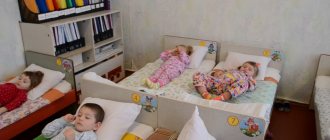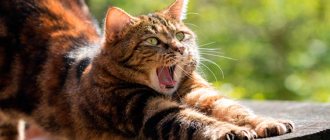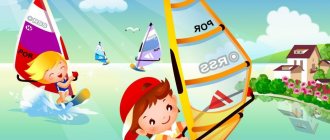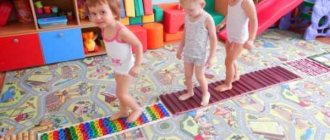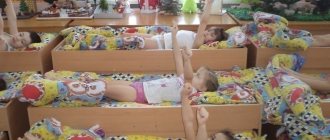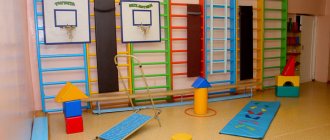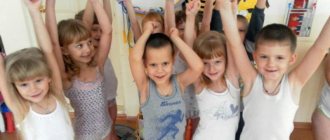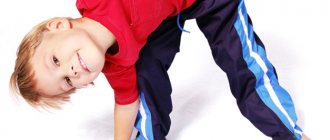Hardening of preschool children
Hardening is an important element of a healthy lifestyle for a person at any age. But it is of particular importance for children whose bodies have not yet developed the ability to quickly adequately respond to sudden changes in environmental conditions. Children overheat and become hypothermic faster than adults, and are more sensitive to humidity (especially high humidity in the outside air - dampness), and ultraviolet rays. Children whose hardening began at an early age get sick less often and have an easier time adapting when entering kindergarten.
Let us list the basic principles of hardening:
- hardening must begin in a state of full health;
- the intensity and duration of hardening procedures should increase gradually, taking into account the child’s tolerance;
- the effect of hardening depends on the systematicity of its implementation;
Air hardening procedures are included in the normal daily routine:
- air baths when changing a child’s clothes and during morning exercises;
- sleep in a well-ventilated bedroom with access to fresh air (open transoms, windows);
- maintaining optimal temperature conditions in the room (temperature +18…20°C)
- daily walks in the fresh air for 3-4 hours in the fresh air in any weather train the child’s thermoregulatory mechanism, adapting it to fluctuations in temperature, humidity, and air movement;
- clothing should be light , not restrict movement, with a minimum content of artificial and synthetic materials;
During walks, monitor the child’s condition and regulate his physical activity. If he is sweating, he needs to be taken home and changed clothes. Remember that clothes drying on a child cause hypothermia.
Sun hardening begins with light-air baths in the shade of trees, then moves on to local sunbathing, leaving certain parts of the body, arms, and legs exposed. Sun hardening: the duration of the air bath in the first days is 2-3 minutes. Every day the exposure increases by 40 seconds, bringing the stay undressed to 15-20 minutes. The duration of baths gradually increases; they are carried out under the control of the child’s well-being. The child's head should be constantly protected from the sun's rays with a light-colored Panama hat. In the hot summer laziness, kids definitely need a drink. The best time to take a bath is from 10 to 11 am.
The most effective hardening method is water hardening . It should also be firmly established in the daily routine of preschool age in daily procedures:
- washing hands after sleeping or using the toilet with warm water and soap. Then - alternately washing your hands up to the elbows, face, neck, upper chest with warm and cool water;
- brushing your teeth followed by rinsing your mouth with cool water;
- gargling with boiled water after eating with a gradual decrease in its temperature from 36 to 22 ° C by 1 ° C every 5 days;
Special hardening water procedures include:
- wiping the body. Rubbing body parts (arms, chest, back) begins with dry rubbing until the skin is slightly red with a mitten or shaggy towel for 7-10 days. Then wet wipes are performed, the water temperature is reduced from 30...32 °C to room temperature by 1 °C every 2 days. The duration of the procedure is up to 3 minutes. At the end there is a dry rub;
- In order to harden preschoolers, you can use contrast dousing of feet with water . For weakened children who often suffer from acute respiratory infections, a gentle dousing regime is recommended, when they first pour warm water on their feet (+38...36°C), then +28°C and finish with warm water again. For healthy children, a higher contrast is recommended: +38 - +18 - +38 - +18°C. Finish the procedure with dry rubbing. Pouring is carried out from a jug or watering can with a perforated nozzle.
- you can use contrasting douches for the hands , the temperature regime is the same as when dousing the feet.
- general body douches are carried out with water from an initial temperature of +36°C, the duration of the first douche is 15 seconds. Subsequently, the water temperature gradually decreases by 1°C per week, and the duration increases to 35 seconds.
- The “Health Path” has proven itself well in terms of hardening:
1) rubber mat with spikes
2) mat
3) mat with spikes
4) ribbed board
5) rubber mat with stripes
6) box with pebbles
The first part is burlap, moistened with water 40C, cooled to 35-36C, followed by a towel;
The 2nd part is a runner without burlap, immediately a carpet runner.
In the event of a child’s illness, hardening procedures are resumed using a gentle regimen 1-2 weeks after complete recovery, depending on the nature of the disease. The water temperature should be 2-3 degrees higher than before the child became ill.
The most powerful hardening factor, harmoniously combining the pleasant and useful - swimming . Exercises on the water have a complex effect on the entire body, swimming strengthens it and hardens it.
Basic rules for hardening a child:
- You can start hardening at any time of the year.
- Hardening is effective only when it is carried out systematically; Without constant reinforcement, the results achieved decrease.
- You cannot sharply increase the duration and strength of hardening effects. Violation of the principle of gradualness can cause hypothermia and illness in the child.
- Hardening procedures cannot be started if the child is sick.
- The effectiveness of hardening procedures increases if they are carried out comprehensively.
The child should like the procedure and evoke positive emotions. Caution, gradualism, systematicity are three principles that must be strictly adhered to when hardening the child.
Secrets of children's health
Parents should remember that hardening does not provide a 100% guarantee of the absence of diseases. This is just one of the important components of a healthy lifestyle. It is also necessary to take care of proper nutrition and create a healthy microclimate, and also not to forget that the body needs immune support “from the inside.” For this purpose, experts recommend the use of special drugs - immunomodulators, capable of maintaining the immune system in full combat readiness, which is also important during hardening, when the body is subjected to serious tests. One of the most effective and safe preventive agents recommended in domestic pediatric practice is Anaferon for children. When taking this drug, reliable protection is provided against viruses, to which a weakened body is especially susceptible.
Air baths.
The first hardening procedure for an infant is air baths. It must be remembered that the air temperature in the room for a newborn baby should be 23°C, at the age of 1 to 3 months. — 21°С, from 3 months. up to 1 year - 20°C; over 1 year - 18°C. Infants have high energy costs and oxygen consumption (2.5 times more than adults), so it is necessary to ventilate the premises 4-5 times a day for 10-15 minutes. in winter, keep the windows open almost constantly in summer. Ventilation using a window or transom is carried out in the presence of children; the air temperature drops by 1 - 2°C, which is a hardening factor. It is advisable to carry out cross-ventilation when there is no child in the room. It is possible to use air conditioners and microclimate systems that automatically regulate temperature and humidity.
In the summer, newborns can be taken for a walk almost immediately after birth, initially for 20-40 minutes, quickly increasing the time to 6-8 hours a day.
In winter, children are first taken outside at the age of 2 - 3 weeks at an air temperature of at least -5 ° C for 15 - 20 minutes. and gradually increase exposure to air to 1.5 - 2 hours 2 times a day.
Air baths themselves begin to be carried out in the maternity hospital, when, when changing diapers, the child is left for a short time without clothes. Air baths should be carried out in a well-ventilated room at an air temperature of 20 - 22 ° C (for infants) and 18 - 19 ° C (for children 1 - 2 years old). Initially, the duration of the procedure is 1 - 2 minutes, every 5 days it increases by 2 minutes. and reaches up to 15 minutes (for children up to 6 months) and up to 30 minutes (after 6 months). Air baths must be combined with gymnastic exercises.
Contrasting and non-traditional hardening.
Intensive (non-traditional) hardening methods include any methods in which there is at least short-term contact of a naked human body with snow, ice water, or subzero air.
There is sufficient experience in intensive hardening of young children in parental health clubs. However, there are practically no scientific studies indicating the possibility of using this type of hardening. Therefore, most authors dealing with the issues of hardening young children consider bathing children in ice water to be contraindicated.
There is contrast hardening as a transitional step between traditional and intensive hardening: contrast foot baths, contrast rubdown, contrast shower, sauna, Russian bath, etc. Contrast hardening is more effective than hardening only with cold. The most common method for children is contrast dousing of the feet (you cannot pour cold water on cold feet, the feet must first be warmed).
There are also so-called pharmacological methods of hardening - the use of immunostimulants that enhance interferon formation. Some authors recommend their use for the prevention of frequent respiratory diseases in young children. However, this issue has not been sufficiently studied, and the results of the therapeutic experience indicate that there is no effect of treatment with immunostimulants on the level and dynamics of respiratory morbidity.
Hardening after a nap in the older group
Breathing exercises.
Healthy exercises for the throat. 1. "Horse". Remember how a horse's hooves clatter along the pavement. We click our tongue, now louder, now quieter. We either speed up or slow down the speed of the horse. 2. "Crow". A crow sat on the fence and decided to entertain everyone with its beautiful song. First he raises his head, then he turns to the side. And her cheerful croaking can be heard everywhere. Children pronounce “ka-a-a-aar” in a drawn-out manner. Repeat 5-6 times. 3. “Snake tongue.” We imagine how a long snake tongue tries to stick out as far as possible, trying to reach the chin. Repeat 6 times. 4. “Yawning.” Sitting, relax; lower your head, open your mouth wide. Say out loud “o-o-ho-ho-ho-o-o-o-o” - yawn. Repeat 5-6 times.
Water procedures.
Tap, open! Nose, wash your face! Wash both eyes at once! Wash your ears, wash your neck! Neck, wash yourself thoroughly! Wash, wash, shower! Dirt, wash away! Dirt, wash away!!!
GYMNASTICS COMPLEX AFTER DAY SLEEP No. 5 (Nov)
middle group
Target:
raise the mood and muscle tone of children through physical exercise, eliminate drowsiness and lethargy, help the body “wake up”; developing motivation in children to maintain and improve health; formation of correct posture, prevention of flat feet.
Equipment:
MP3 player, audio recording with calm music, small objects (fabric), “health tracks”.
Gymnastics in bed.
"Stretching"
I.p.
– from the “lying on your back” position in bed. 1. As you inhale, the left leg stretches the heel forward along the bed, and the left arm stretches upward along the body. Breathing is held, legs and arms are stretched as much as possible. As you exhale, relaxing, the child says: “id-d-da-a-a-a.” 2. The right leg stretches the heel forward along the bed, and the right arm goes up, along the body - inhale. After holding your breath, as you exhale, pronounce “pin-gal-la-a.” 3.Both legs are stretched with their heels forward along the bed, both arms are stretched up along the body. Hold your breath and, as you exhale, slowly say “su-shum-m-m-na.”
Prevention of flat feet. I.p.
. - standing near the bed. 1. “Shortening” the feet. 2. Rolling from heel to toe and from toe to heel. 3. Picking up small objects (fabrics) from the floor with your toes. 4. Bringing and spreading your heels while standing on your toes. 5. Squat on your toes. Walking barefoot along the “health path”.
Hand massage.
1. “Wash” your hands, actively rub your palms until you feel intense warmth. 2. Pull out each finger and press on it. 3. Rub the phalanges of the fingers of one hand over the nails of the other hand, as if on a washboard.
Prevention of postural disorders
, breathing exercises.
Physical education I.p.
- standing between the beds.
Here's a dragonfly
, (stand on your toes, arms up at your sides)
Eyes like peas
.
(join the index and thumb of both hands in a circle, put them to the eyes (“glasses”), turns to the sides) And herself, like a helicopter
, (rotate the forearms back and forth with a half turn to the left, right, back, forward. left to right; tilts to the sides)
And there is dew on the grass
, (squat)
And there is dew on the bushes
.
(bends forward, bending over) We shook off our palms
, (claps in front of us, hands alternately up and down)
The dragonfly flew away
.
(small frequent movements of the hands, arms to the sides) The jumper got scared
, (hands behind the head, tilts left and right)
Only the song remained
. (cup your palms like a mouthpiece and “sing”: “D-z-z-z, d-z-z -z, z-z")
Middle group. Junior preschool age. Children 4 - 5 years old
Summary of hardening procedures after daytime sleep in the middle group. Summary of hardening procedures after daytime sleep in the middle group. Educator: Pugina K.V. 2022. Purpose: Prevention of colds using hardening procedures . Tasks. Educational: Preserve and strengthen the physical and mental health of the child….
Organization of physical education, health and hardening activities in the middle group The most precious gift that a person has received from nature is health. No matter how perfect medicine is, it cannot save each of us from diseases. “Every person’s health comes from physical education, hardening , and a healthy lifestyle!” - these words belong to the great...
Sun hardening.
Ultraviolet rays actively affect the immunological resistance of the body. However, the younger the child is, the higher the sensitivity to ultraviolet rays. Therefore, sunbathing is contraindicated for children under one year of age. They are prescribed with caution to children from 1 to 3 years of age, and only at an older age they are carried out quite widely. Scattered sunlight contains a lot of ultraviolet and relatively few infrared rays, which cause overheating of the child’s body, which is especially dangerous for children with increased neuro-reflex excitability.
In autumn, winter and spring, direct sunlight does not cause overheating, so getting it on the child’s exposed face is not only acceptable, but also necessary. In summer, it is recommended to carry out light-air baths at an air temperature of 22 ° C and above for infants and at 20 ° C for children 1 - 3 years old, preferably in calm weather. In central Russia, light-air baths are best carried out from 9 to 12 noon, in hotter climates from 8 to 10 am. The duration of the first bath for infants is 3 minutes, for older children - 5 minutes. with a daily increase to 30 - 40 minutes or more. An absolute contraindication to sunbathing is an air temperature of 30°C or higher. After sunbathing, children are prescribed water treatments. Since the body becomes hypothermic when the skin is wet, it is imperative to dry the child, even if the air temperature is high.
